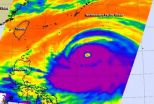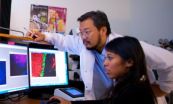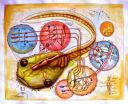(Press-News.org) From July 4 to July 7 Tropical Cyclone Neoguri strengthened from a tropical storm into a supertyphoon. NASA's Terra and Aqua satellites passed over the rapidly intensifying storm and provided forecasters with visible, infrared and microwave data on the powerful supertyphoon.
On July 4 at 0900 UTC (5 a.m. EDT) Neoguri had maximum sustained winds near 55 knots (63.2 mph/101.9 kph). It was located near 13.1 north and 141.4 east, about 207 nautical miles (238.2 miles/383.4 km) west of Andersen Air Force Base, Guam. It was moving to the northwest at 13 knots (14.9 mph/24.0 kph). This visible image from the MODIS instrument aboard NASA's Aqua satellite at 03:40 UTC on July 4 showed the bulk of the clouds and showers south and east of a clear eye.
NASA's Terra satellite passed over Neoguri as it became a typhoon on July 5. At 01:20 UTC (July 4 at 9:20 p.m. EDT) the Moderate Resolution Imaging Spectroradiometer known as MODIS that flies aboard Terra captured a visible image of Neoguri as it moved through the Northwestern Pacific Ocean. The MODIS image showed a clear eye, and a large, thick band of thunderstorms in the southern quadrant of the storm wrapping into the center.
On July 5 at 0900 UTC (5 a.m. EDT) satellite data helped confirm that Neoguri had become a typhoon in the Northwestern Pacific after it passed Guam. At that time it was centered near 16.0 north and 137.0 east, about 813 nautical miles (935.6 miles/1,506 km) southeast of Kadena Air Base. It was moving west-northwest at 14 knots (16.1 mph/25.9 kph) and had maximum sustained winds near 115 knots (132.3 mph/213.0 kph).
On July 6 Typhoon Neoguri continued to strengthen. Neoguri was located near 18.5 north and 131.4 east at 0900 UTC (5 a.m. EDT) on July 6. That's about 661 nautical miles (760.7 miles/1,224 km) southeast of Kadena Air Base, Okinawa, Japan. It had maximum sustained winds near 120 knots (138.1 mph/222.2 kph) and was moving to the west-northwest at 15 knots (17.2 mph/27.7 kph). The Joint Typhoon Warning Center or JTWC noted that Neoguri was generating very rough and high seas as high as 32 feet (9.7 meters).
A false-colored infrared image of Supertyphoon Neoguri on July 6 at 17:17 UTC (1:17 p.m. EDT) was made at NASA's Jet Propulsion Laboratory in Pasadena, California using data from the Atmospheric Infrared Sounder (AIRS) instrument. AIRS flies aboard NASA's Aqua satellite. The infrared imagery showed very cold, high, powerful thunderstorms around the center of Neoguri's 40-nautical-mile-wide-eye and in a thick band south of the center.
By July 7 at 1500 UTC (11 a.m. EDT), Neoguri had grown into a supertyphoon with maximum sustained winds near 130 knots (149.6 mph/240.8 kph). The JTWC expects Neoguri to strengthen further. Neoguri was located near 21.6 north latitude and 127.3 east longitude, about 246 nautical miles (283.1 miles/455.6 km) south-southwest of Kadena Air Base, Okinawa, Japan. It was moving to the northwest at 15 knots (17.2 mph/27.7 kph). As Neoguri strengthened, the ocean has become more turbulent, and JTWC estimates maximum significant wave heights near 40 feet (12.1 meters).
Tropical storm-force winds extend 210 nautical miles (241.7 miles/388.9 km) from the center, and hurricane-force winds extend up to 60 nautical miles (69.0 miles/111.1 km) from the center.
For a graphic of watches in warnings in effect in Japan, visit the Japan Meteorological Agency's page: http://www.jma.go.jp/en/warn/.
Neoguri is moving northwest and continuing to strengthen. The JTWC expects Neoguri to turn to the north late on July 7 (EDT) and pass Kadena Air Base. A landfall in Kyushu is expected by July 9. The JTWC noted in a July 7 discussion: by July 9, cooling sea surface temperatures, increasing vertical wind shear ahead of the mid-latitude westerlies (winds), and landfall into Kyushu, Japan, will slowly erode the system.
INFORMATION:
NASA satellites see Neoguri grow into a super typhoon
2014-07-07
ELSE PRESS RELEASES FROM THIS DATE:
The new atomic age: Building smaller, greener electronics
2014-07-07
(Edmonton) In the drive to get small, Robert Wolkow and his lab at the University of Alberta are taking giant steps forward.
The digital age has resulted in a succession of smaller, cleaner and less power-hungry technologies since the days the personal computer fit atop a desk, replacing mainframe models that once filled entire rooms. Desktop PCs have since given way to smaller and smaller laptops, smartphones and devices that most of us carry around in our pockets.
But as Wolkow points out, this technological shrinkage can only go so far when using traditional transistor-based ...
Study reveals protective role for specialized cells in intestinal and respiratory systems
2014-07-07
RIVERSIDE, Calif. – Ripping a page from the Star Trek script, specialized cells of the barrier that lines the inside of the intestines and airways of humans have invoked a biological version of Captain Kirk's famous command "shields up" as a first defense against invading microbes.
Research in the UCR School of Medicine laboratory of David Lo found that certain cells of the epithelium have a potentially important role in immune surveillance – creating an electrostatic repulsion field to microbial invasion.
The study is featured on the cover of the July issue of Infection ...
Expectant moms turn to 'Dr. Google' for pregnancy advice
2014-07-07
Pregnant women are using the Internet to seek answers to their medical questions more often than they would like, say Penn State researchers.
"We found that first-time moms were upset that their first prenatal visit did not occur until eight weeks into pregnancy," said Jennifer L. Kraschnewski, assistant professor of medicine and public health sciences, Penn State College of Medicine. "These women reported using Google and other search engines because they had a lot of questions at the beginning of pregnancy, before their first doctor's appointment."
Following the women's ...
Summer McJobs are good for kids, says UBC study
2014-07-07
A new UBC Sauder School of Business study shows that teenagers who work at summer or evening jobs gain a competitive advantage later in life. Developing early knowledge of the working world and how to manage in it, they are more likely to find good employment and earn more money in the future.
"With summer in full swing and kids sitting on the couch, parents are wondering whether to push them to find a job," says Sauder professor Marc-David L. Seidel, who co-authored the study. "Parents may think that their kids could do better than a job at the local fast food joint. ...
For a holistic approach to POW trauma
2014-07-07
The full circumstances of U.S. soldier Bowe Bergdahl's captivity have yet to be revealed. During his tour of duty in Afghanistan in 2009, Bergdahl was captured by the Taliban and held in captivity for five years until a controversial prisoner exchange led to his release on May 31. Bergdahl has been accused of deserting his post and advocating the release of Afghani prisoners.
"We do know that he suffered horrific conditions, tortured and kept in a metal cage in darkness for weeks on end," said Prof. Zahava Solomon, an Israel Prize laureate, Professor of Social Work and ...
Patient patience and pandemics
2014-07-07
Allowing patients to choose which hospital they attend when suffering illness during a pandemic rather than assigning them to a specific healthcare facility is appealing to patients during such a crisis. However, such a patient-centric hospital capacity management is conventionally viewed as inefficient system-wide. According to research published in the International Journal of Mathematics in Operational Research, an incentive-based approach for hospital capacity management can not only accomplish a high efficiency for a concerned hospital system but satisfy patients' ...
World Cup chemistry: The science behind the 'brazuca' (video)
2014-07-07
WASHINGTON, July 7, 2014 — The World Cup final is almost here, and no matter which two teams meet for the title match, there's one thing they'll both need to win: the ball. This week, Reactions examines the chemistry that goes into making the "brazuca," and what makes it different from most other soccer balls out there. The video is available at https://www.youtube.com/watch?v=1XNTfslUzt8.
INFORMATION:
Subscribe to the series at Reactions YouTube, and follow us on Twitter @ACSreactions to be the first to see our latest videos.
The American Chemical Society is a nonprofit ...
Infant toenails reveal in utero exposure to low-level arsenic, Dartmouth study finds
2014-07-07
Infant toenails are a reliable way to estimate arsenic exposure before birth, a Dartmouth College study shows.
The findings appear in the Journal of Exposure Science & Environmental Epidemiology. A PDF of the study is available on request.
A growing body of evidence suggests that in utero and early-life exposure to arsenic may have detrimental effects on children, even at the low to moderate levels common in the United States and elsewhere. The fetus starts to develop toenails during the first trimester, making them an accurate measure of exposure to arsenic during ...
GVSU researchers find moral beliefs barrier to HPV vaccine
2014-07-07
GRAND RAPIDS, Mich. — A survey of first-year Grand Valley State University students showed the biggest barrier to receiving a Human Papillomavirus (HPV) vaccine was moral or religious beliefs, or a perceived promotion of sexual behavior, according to graduate physician assistant researchers.
Physician Assistant Studies majors Jamie Phillipich and Margie Webb surveyed 1,000 incoming students last fall as part of their master's research project. They assessed the influence media has on the perception of HPV and vaccine compliance, and presented their findings at the Annual ...
Dodging dots helps explain brain circuitry
2014-07-07
PROVIDENCE, R.I. [Brown University] — A neuroscience study provides new insight into the primal brain circuits involved in collision avoidance, and perhaps a more general model of how neurons can participate in networks to process information and act on it.
In the study, Brown University neuroscientists tracked the cell-by-cell progress of neural signals from the eyes through the brains of tadpoles as they saw and reacted to stimuli including an apparently approaching black circle. In so doing, the researchers were able to gain a novel understanding of how individual ...





